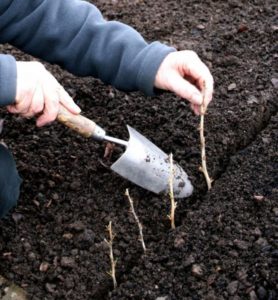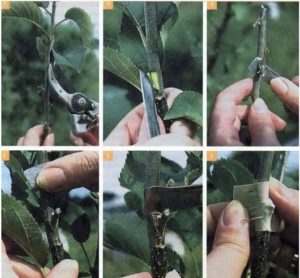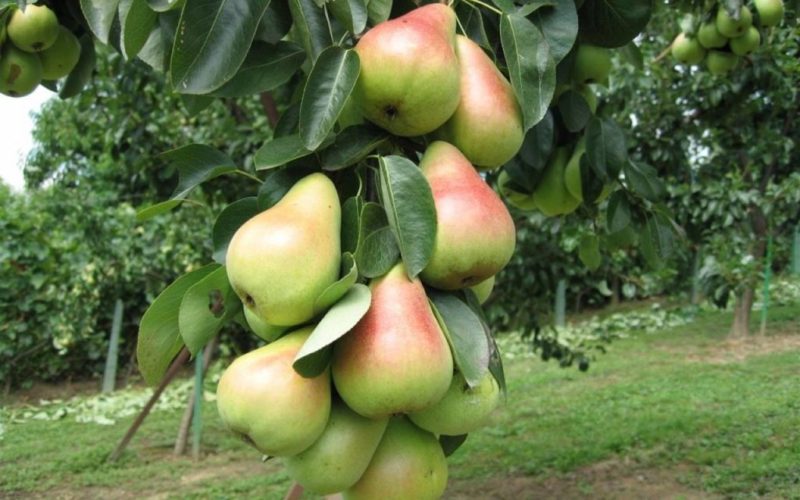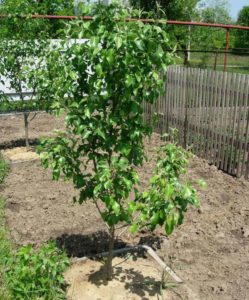How to cut a pear in the summer: step-by-step instructions and useful tips
Reproduction of pears in the garden is an interesting and laborious activity. It is necessary to determine the timing so as not to stretch out and start the procedure too early, otherwise the tree will not take root. The choice of varieties suitable for breeding depends on the region where the transplant will take place. Do not forget that each variety has its own characteristics, advantages and disadvantages. How to propagate (cut) a pear in the summer, you will learn from our article.
The content of the article
Is it possible to propagate a pear by cuttings in summer
In summer, the pear is propagated by cuttings. A tree grown in this way begins to bloom in the fifth or sixth year of development.
Advantages and disadvantages of the procedure
One of the advantages of pear cuttings in summer is the ability to take root before the onset of severe cold weather, although experienced gardeners claim that trees grown by this method are not as frost-resistant as those that are propagated by grafting.
Other advantages:
- such plants tolerate high groundwater levels better;
- they are easy to propagate in various ways;
- they don't need vaccination.
Cutting allows you to grow high-quality and own-rooted fruit trees. The procedure itself is simple: following the rules, even an inexperienced gardener will perform it.
However, this method of growing pears also has disadvantages:
- in the summer heat, they need shelter from direct sunlight;
- give average or poor yields compared to trees grown in other ways;
- do not bear fruit every year;
- there is no guarantee that the process will take root.
Optimal timing for summer cuttings
In the regions of the middle lane, pear cuttings begin from June 12 or 15. Finish on July 14 or 15.
In the northern regions of the country, the procedure should start from June 20 and finish before July 10. With this type of reproduction, these periods are important, since the plant may not take root.
Auspicious days
It is better to harvest the cuttings in the morning, in cloudy weather. At this time, the cut branches contain a large amount of moisture, which contributes to the rapid survival of the shoot.
Some gardeners are guided by the lunar calendar and plant a cutting on the growing moon.
Auspicious days in summer 2020:
- June 1-4 and 22-30;
- July 1-4 and 21-31.
Suitable varieties of pears
Varieties pears suitable for this growing method:
- Autumn Yakovleva;
- Lada;
- Muscovite;
- Memory of Zhigalov.
Selection and preparation of cuttings
In the morning, the processes are cut off. The length of the branches is determined based on the size of the internodes. If they are short, 3 pieces are left on the process, long - 2 pieces. It is not recommended to cut thin branches as they do not take root well.
Lignified shoots are used for reproduction in the fall. Cut off after the fall of leaves, when the movement of the juice has ceased.
Green cuttings are carried out in the summer. One smooth cut is made with a sharp knife towards the kidney. Then a second cut is made - above the upper kidney and horizontally.
Cut and air layering. In early June, a healthy branch is taken and the bark is cleaned. The resulting cut is disinfected with a fungicide solution and treated with a growth activator. Then cut the plastic cup into 2 halves and fill them with earth.Apply to the cut and wrap with a white cloth to protect it from overheating. Moisten the soil after a few days.
After a month, the glass is removed from the cut. Roots 10 cm long will appear from the branch. The shoot is separated from the tree and planted in a prepared hole.
Rooting methods
To allow the shoot to take root, it is planted in a wooden box. The bottom is covered with river sand. The second layer is the earth saturated with minerals. It is moistened with a spray bottle.
Attention! The soil layer must be at least 30 cm. The stalk is planted in the ground for more than half of its length. Only 2 eyes are left above the ground.
The box is covered with plastic wrap to create a greenhouse environment. Ventilate once every 7 days. The film is removed after half a month.
Planting ready-made cuttings
By the second half of September, ready-made shoots are transplanted into a greenhouse. By this time, the pear should already take root. In order not to damage them, the plant is carefully removed with a clod of earth.
The soil in the greenhouse is kept moist if the autumn is hot. The greenhouse is ventilated. Closer to winter, shoots are covered with sawdust, peat or spruce branches.
A pear is grown in a greenhouse for 3 years. Then the tree is transplanted to a plot or garden.
Breeding features depending on the type of pear

Columnar pears are propagated by grafting on wild stocks. Green shoots are also rooted, vegetative material is harvested in the fall. Columnar pears, however, need annual side pruning.
For the stock, they use a forest pear, Ussuri game. They also practice autumn tree cuttings for Otradnenskaya and Lada varieties.
Depending on the region
Pear is a thermophilic crop, therefore it is grown mainly in the southern regions.
For example, in the Voronezh region, varieties of different ripening periods are cultivated. The pear bears fruit well in loamy areas, but the soil should be loose.
A pear on a red mountain ash is grown in the Central Black Earth Region, since the low average temperature of the region is not suitable for rootstocks for other crops.
It is interesting:
The best summer varieties of pears: description and characteristics
The best varieties of pears for the Moscow region
The chemical composition of the pear, calorie content and its benefits and harm to health
Further care

In the spring, the seedling begins to grow actively. It must be watered so that the soil does not dry out.
A groove is made around the perimeter of the hole, a stream of water is directed into it. Evening sprinkling will be especially appreciated by the pear.
Both organics and mineral complexes are suitable fertilizers for wood. In August, ash is additionally introduced along with phosphates.
The seedling is treated with antifungal drugs. For the winter, the trunk and the trunk circle are insulated with sawdust, 3 layers of lutrasil. The tree is additionally wrapped in foil.
In the spring, green manures are planted around the young pear. They loosen the soil, and after dying off, they give substances that are useful for a young tree.
Experienced gardening tips
If you follow these tips, a healthy and fruitful tree will grow from the cuttings:
- seedlings are sent to the basement for the winter;
- pruning of branches is carried out after transplanting to a permanent place;
- provide diffused lighting in the greenhouse;
- cuttings are taken from the lower part of the crown - they grow more actively.
Conclusion
Cutting a pear is a laborious process that should be taken seriously. It includes not only skillful reproduction in various ways, but also the subsequent care of culture.
By following the tips above, you can grow a strong tree from the cuttings. Timely watering and feeding will help the gardener in this difficult task.